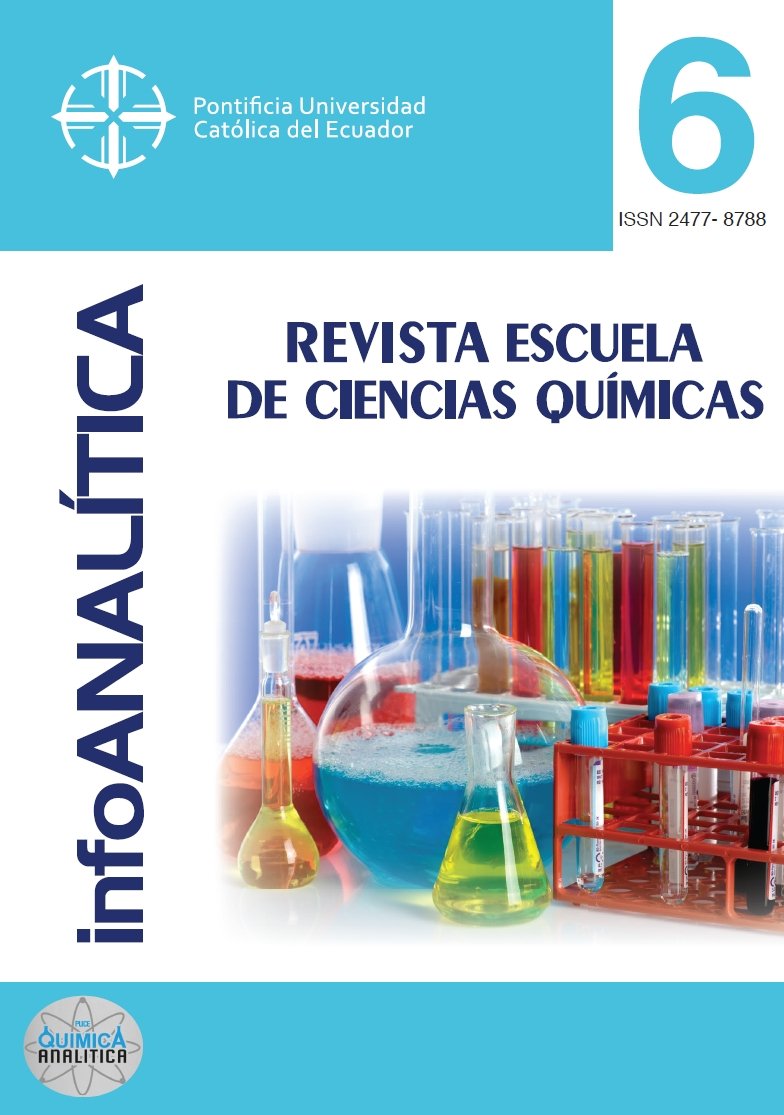Study of aerobic biodegradability of HDPE with degradable additives by composing
Main Article Content
Abstract
The study determinate the percentage of biodegradability of samples of high density polyethylene (HDPE) with degrading additives, in controlled conditions in a period of 90 days for which the generation of CO 2 from biological processes of soil microorganisms was used as an indicator of biodegradability. For the absorption of CO 2 were used solutions of 0.1 M and 0.5 M KOH. In addition, the analysis parameters stipulated in the standard NTE INEN 2040: 2012 were established to select the composting inoculum. As a positive control was used cellulose which reached 91 % of biodegradability with respect to the theoretical value of CO 2 that this material can generate. The results obtained at the end of the 90 days, indicated that the HDPE sample with A1 additive reached 75 % biodegradability by CO 2 generation, followed by HDPE-A2 with 43 % and HDPE-A3 with 22 % with respect to cellulose. The values show that the additive A1 is biodegradable under composting conditions, this was established by the criterion of the standard NTE INEN 2643: 2012 "Specifications for compostable plastics". The results show that the biodegradable additives are a possible solu- tion to the great environmental problem that have generated the plastics.
Downloads
Article Details
- The authors agree to respect the academic information of other authors, and to assign the copyrights to the journal infoANALÍTICA, so that the article can be edited, published and distributed.
- The content of the scientific articles and the publications that appear in the journal is the exclusive responsibility of their authors. The distribution of the articles published in the infoANALÍTICA Journal is done under a Creative Commons Reconocimiento-CompartirIgual 4.0 Internacional License.
References
ASTM Standard D6954 (2004), Standard Guide for Exposing and Testing Plastics that Degrade in the Environment by a Combination of Oxidation and Biodegradation. West Conshohocken: ASTM International.
Carreira, D. (2011). Cuantificación de la Materia Orgánica del suelo. Método de WALKLEY & BLACK, Jornadas de actualización: Gestión de la calidad en los laboratorios de análisis de suelos agropecuario. Argentina: SAMLA- PROINS, RILSAV.
Capuz, S. y Gómez, T. (2002). Ecodiseño: Ingeniería del ciclo de vida para el desarrollo de productos sostenibles. Valencia: Universidad Politécnica de Valencia.
Chiellini, E. y Solaro, R. (2003), Biodegradable Polymers and Plastics. Pisa: University Pisa.
Ecuador al día (2014). Ecuador produjo más de 1.400 millones de botellas plásticas en 2013. http://www.ecuadoraldia.com.ec/blog/2014/05/17/ecuador-produjo-mas-de-1-400-millones-de-botellas-plasticas-en-2013
Eldor, P. (2007). Soil Microbiology, Ecology and Bochemistry. (3. ed.). Reino Unido: Elsevier Inc.
El Telégrafo (2015). La industria plástica produce al menos $ 418 millones al año. http://www.eltelegrafo.com.ec/noticias/economia/8/la-industria-plastica-produce-al-menos-418-millones-al-ano
FAO (2003), On-farm Composting Methods. Rome: FAO.
Kalil, P. (2007). Seguimiento del proceso de humificación en compost inoculado. Proyecto de grado Microbiología Industrial, Pontificia Universidad Javeriana, Bogotá D.C, pp17
Norma Técnica Ecuatoriana INEN 2640:2012 Método de Ensayo para Determinar la Biodegradabilidad Aeróbica de Materiales Plásticos Bajo Condiciones Controladas de Compostaje
Román P., Martinez M. y Pantoja, A. (2013). Manual de compostaje del agricultor, Experiencias en América Latina. Santiago de Chile: Centro de Información de Recursos Naturales (CIREN).
San Andrés, M. (2010). Factores responsables de la degradación química de los polímeros. Efectos provocados por la radiación lumínica sobre algunos materiales utilizados en conservación: primeros resultados. http://ccfib.mcu.es/patrimonio/docs/MC/POLYEVART/FactrespXIReinaSof.pdf

